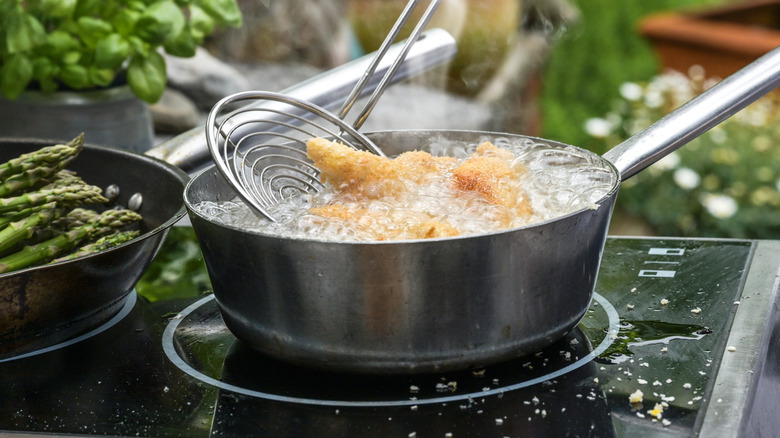The Simple Way To Quickly Check Your Oil Temperature For Successful Frying
When it comes to frying foods at home, getting the temperature right is essential. If the oil isn't hot enough, you can end up with a soggy, oily finished dish. Too hot, and the outside will cook too fast, resulting in burned breading and a raw center. Just right, and the outside is crisp and golden brown while the inside is juicy and delicious. Fortunately, it is actually pretty easy to find the right frying temperature without any extra equipment. All you have to do is toss a little pinch of your breading material into the hot oil — like breadcrumbs or a bit of flour — and it'll let you know.
What you are looking for when you add the breading to the hot oil is a nice, gentle bubbling. If the oil is too cold, the breading will just sit in the oil or sink to the bottom. If it's too hot, it will bubble aggressively and quickly burn. Smoking oil is another good indicator that your frying oil needs to cool down a bit before you try to fry up the main dish. But when you add the breading and it calmly bubbles away, you can rest assured that you'll get a nice cook — and you'll skip over two of the most common mistakes everyone makes when frying food in one simple step.
This method works well in most settings, especially if you don't have a complete complement of kitchen tools. However, creative cooks have come up with plenty of other methods of ensuring optimal frying temperature.
Other ways to check that your oil is ready for frying
You can check your oil temperature with plenty of other items that you likely have around the kitchen. For example, Martha Stewart's technique for checking frying oil is to drop a cube of bread into the pot or pan. With this trick, look for the same result as you would see when using the aforementioned breading or bread crumbs. Alternatively, you can use the spoon trick for testing frying oil, where you stick the handle of a wooden spoon into the pot, again looking for gentle bubbles.
What you are actually observing in all of these situations is the evaporation of liquid from whatever you are adding to the pot. So make sure that whatever you put into the oil is fairly dry. Oil and water do not mix, and hot oil and water especially don't. Something relatively dry, like a piece of bread, will gently bubble as the water in the bread turns to steam, and these bubbles rise to the surface of the oil.
But if there is too much water in whatever you add, the reaction can be violent, with lots of spattering and a high risk of a grease fire. This is why it's important to keep food dry when frying and why you should never check oil temperature by adding even a tiny bit of water to the pot. Even if you don't start a fire, a small drop of water can lead to oil spattering and burns. The surest technique is to use a gadget you might already have in your kitchen.
Thermometers are your best friend for frying
As mentioned above, temperature in fried foods can make all the difference in the finished product, and there's no better tool for the job than a thermometer. With a meat thermometer or candy thermometer, you can quickly assess the exact temperature of the oil and know whether it is ready. This Candy Thermometer with Pot Clip can be inserted into deep pots of oil, as for deep frying, and attached to the rim. It allows you to keep a constant eye on the temperature and add your food to the pot when the time is just right. But any thermometer will do, and if all you have is something like this Lonicera Digital Meat Thermometer, you can just stick it in the oil every once in a while to keep an eye on things.
The perfect temperature for frying depends on what you are making, but in general you are looking for around 325 to 375 degrees Fahrenheit. For foods that need longer to cook through, like fried chicken, you'll want to start on the lower end. Lower temperatures mean a longer window before the breading is just right, which gives more time for internal heat transfer. With something that doesn't need to cook in the middle but just to crisp up, such as potato chips, you can aim for the higher end of that range. That said, once you've done it a few times, you can make a pretty good guess at the perfect oil temperature the old-fashioned way too, by just giving it that sprinkle of breading.


